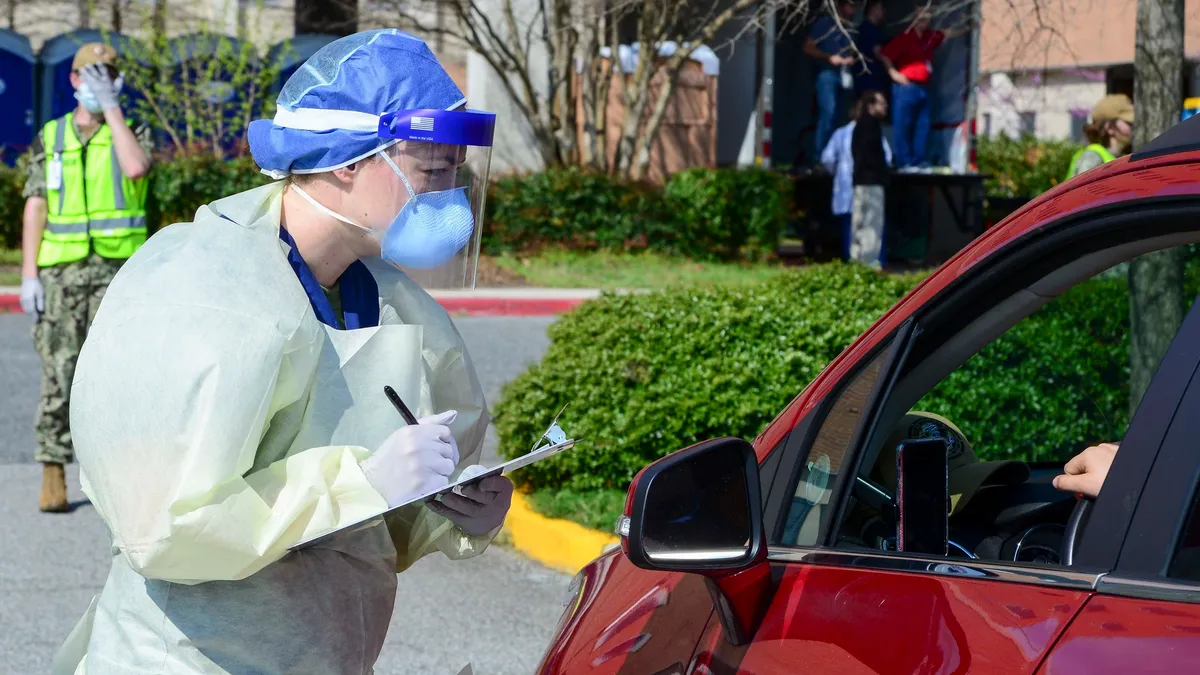As states around the country reopen, a new practice has emerged that experts say is now critical to maintaining workplace safety and business continuity: contact tracing. Employers looking to prevent and curb the spread of COVID-19 may benefit from contact tracing, they say, but there are many factors to consider when rolling it out.
"To enable safety, employers are asking more of their employees and colleagues — including in some cases daily health screeners or declarations, temperature checks and other screening protocols as well as contact tracing," Brett Davis, general manager of ConvergeHEALTH at Deloitte, told HR Dive. "This comes with a number of new compliance requirements — and risks — around consent, transparency of data use, security and privacy that look much closer to the compliance requirements of healthcare systems."
A contact tracing system often will involve apps, reporting channels, proximity-based communication technology and monitoring through personal items such as ID badges, phones and computers. It may also involve cooperation with local health departments. The purpose of this system is to track which people are at risk when an individual tests positive for the novel coronavirus and what preventative actions business or public health officials may need to take. Those who have been within six feet of the affected individual for more than 15 minutes should be contacted and notified of the risk, according to the CDC.
Contract tracing is "the key to safely reopening the economy," experts told ProPublica health reporter Caroline Chen. Chen also pointed out that contact tracing has been used since the 1930s as a way to contain the spread of communicable disease. What makes COVID-19 different from other outbreaks is that many unknowns still exist around how the virus spreads, although many believe technology can combat these challenges.
Weigh the risks
Numerous laws, however, could be implicated. Those include the Fair Labor Standards Act (FLSA), Americans with Disabilities Act (ADA) and U.S. Equal Employment Opportunity Commission guidelines around discrimination, Melissa Boyce, JD, legal editor at XpertHR, told HR Dive. When new safety measures are rolled out, it would be safest to make sure that all employees are required to participate, Boyce and other sources suggested.
"Employers should also ensure compliance with the [FLSA] and similar state and local laws and pay employees for the time spent for both the time waiting to be screened and the screening itself," Boyce said, via email. The compensability of waiting time remains a hot topic in litigation.
Additionally, technology isn't perfect because it doesn't account for mask wearing and other social distancing measures.
The methods for collecting information may vary as well. "For example, an employer can choose to conduct temperature checks of all employees at arrival to the workplace or, in the alternative, allow employees to take their own temperature at home before leaving for work," Boyce said. "An employer may also have employees self-certify on questionnaires that they are not experiencing any symptoms related to COVID-19, have exposure to anyone who has tested positive for COVID-19 or traveled in the past 14 days. […] any inquiries into an employee's medical condition must be directly related to protecting employees and the public from COVID-19."
HR must also consider the data privacy concerns around health screening activity. "The key is that asking employees and contractors for this sensitive data requires robust consent management and transparency in data use and a platform built for managing sensitive personal information, and in some cases health information," Davis said.
Prioritize immediate, transparent communication
With respect to employees, HR leaders risk negative reactions, lack of compliance and panic among the masses, according to Sirmara Campbell, chief human resources officer at LaSalle Network, a national staffing and recruiting firm.
"The last thing employers want to do is cause hysteria among the rest of the workforce if someone tests positive," Campbell told HR Dive in an email. "In order to avoid this, prioritize quick communication. There should be no lag time when it comes to addressing the infected employee and then informing the rest of your workforce."
As in many cases involving the changing times and evolving workplace procedures, employees value transparent communication at all stages, experts say.
"Employees would rather their employer help prevent the spread of disease than be left in the dark," Campbell said. "If employers communicate effectively and employees know their organization is looking out for their health and wellbeing, they will be grateful for the transparency."
Employers may also want to think about providing additional benefits to support buy-in and implementation of safety measures.
"It's important to create a social norm that workers don't come to work when they are sick. Offering sick leave is an important way to discourage working while sick," Jeff Levin-Scherz, North American co-leader of the health management practice at Willis Towers Watson, told HR Dive via email.
While experts agree that public health and workplace safety are the primary benefits to contact tracing, Davis said it is also important for business continuity, an area which many companies were tested when the virus first broke out earlier this year.
"In the event of a second wave or future pandemic," he explained, "the right information platforms combined with the right processes and procedures should help to mitigate spread and, importantly, react to disruptions with more precision within a workplace and in different geographic locations."





















